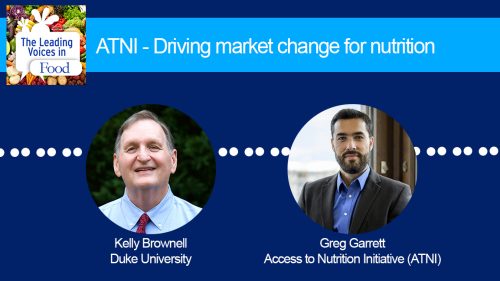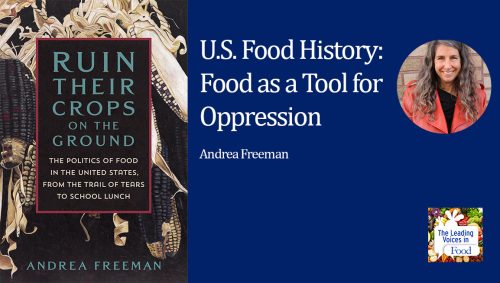The Leading Voices in Food
E169: Ending Childhood Malnutrition is Within our Grasp
So what percentage of the world’s children do you believe suffer from physical or mental stunting due to nutrition and food shortages? How lasting do you think these effects are and what can be done? Today’s guest is Sharman Russell, author of the new book, Within Our Grasp: Childhood Malnutrition Worldwide and the Revolution Taking Place to End It. Among the reviews for the book, The Sunday Times of London said “Every page holds a revelation.”
Subscribe: Apple Podcasts | TuneIN | YouTube Music | SoundCloud | PocketCasts | Radio Public
Tags: Child Development & Nutrition | Childhood Obesity | Diet & Nutrition | Equity, Race & Food Justice | Food Insecurity | Food Policy | International Food & Ag Policy |

Sharman Apt Russell is a nature and science writer based in New Mexico, United States. Her topics include citizen science, living in place, public lands grazing, archaeology, flowers, butterflies, hunger, and Pantheism. Russell is a professor emerita in the Humanities Department at Western New Mexico University in Silver City, where she teaches writing for graduate students. Russell received her MFA in Creative Writing from the University of Montana and her B.S. in Conservation and Natural Resources from the University of California, Berkeley.
Interview Summary
So Sharman, let me begin with sort of a fundamental question. So we led with that issue about how many of the world’s children face these hunger malnutrition stunting issues. And you note it in your book that almost one in four children in the world suffers from physical mental stunting in response to malnutrition and hunger, especially in the early years of life. One thing that’s noteworthy about your book is that you emphasize successful approaches or solutions to ending this kind of childhood nutrition. A lot of people make note of the problem, but finding solutions is a whole different thing all together. But with this issue being so longstanding and complex why do you think there’s reason to be hopeful?
You know, I have been writing about hunger and malnutrition for the last 20 years, and I would never have been drawn to this subject, to this story, if it wasn’t a hopeful one. I also happen to think that hope is the best strategy if you want to achieve something. Hope generates action, and hopelessness does not. For me, this sense of hope is about the last 20 years. At the end of the 20th Century, we finally began to understand the role of vitamins and minerals in the human body and in preventing and treating childhood malnutrition. By the turn of the century researchers had developed this wonderful, precisely fortified food medicine, these convenient packets of a peanut buttery paste, that children love, that don’t need refrigeration or clean water, that can be given by parents in the home. And at the same time, importantly, we realized there isn’t a single approach to ending childhood hunger. Many different things have to happen. Women need to be empowered. Families need good sanitation. They need to be protected from diseases of parasites that aggravate and even cause malnutrition. So we know what to do now. And we also know that for every dollar invested in nutrition, society gets back $16. So we have the motivation. We have the resources. That’s pretty hopeful!
I’m really happy to hear the optimism in your voice. But let me ask a question, a lot of hunger is driven now by climate change and, of course, by political unrest and things. So there’s the knowing what to do about hunger and what people might be fed to help offset the problem. But what about these things going on outside of the nutrient part of it? Is there reason to be optimistic on those fronts?
Those are real challenges. There’s no doubt. We have to remember that nearly a quarter of the world’s children are stunted, damaged because of lack of nutrients. Most of them live in peaceful countries. So while war and conflict is horrible, and what we’re seeing now is absolutely horrible, most children live in peaceful countries. So those are the ones that we can start ending childhood malnutrition right now. The UN Food Systems Summit, last September determined that an additional 33 billion a year for 10 years on improved food systems could end the majority of hunger not caused by war conflict. And they were talking about all hunger, not just childhood malnutrition. So that’s enormously hopeful, 33 billion a year for 10 years! I sometimes use the analogy that Americans are now spending 90 billion a year on their pets and pet products. And I think we should love our pets. Of course, we should love our pets. The important thing is we have the wealth right now to do this.
Right, and you’re talking about worldwide expenses. So America wouldn’t have to be the only country contributing.
We wouldn’t, we shouldn’t be. You know, I think the pandemic really showed us how relatively easy and important it is to spend money on public health. And that’s what we can do pretty easily!
So many of your books are about nature and the environment. And you say often in, Within Our Grasp, that the goals of the environmentalist and humanitarian are aligned. What do you mean by that?
You know, in the book I sometimes say, I often say we come from the earth. Literally we are made up of the periodic table. We take in food and nutrients, and we turn that into who we are. I also say that in a world of 7.9 billion people, we have become the earth. And, and that’s particularly true in terms of population growth. When I was an undergraduate in the 1970s, environmentalists were very concerned about population growth, but I don’t think we understood then the connection between that and poverty. Today, we know that when families believe their children are going to survive and flourish, they tend to have smaller families. When women have access to education and employment they tend to have smaller families. Ending population growth is about ending poverty. You know, in so many ways, the environmentalist and the humanitarian want the same thing. We both want clean air and clean water. We both want sustainable agriculture in the form of agroecology and agroforestry. We both can see that if wildlife is going to thrive, the people living next door to wildlife have to thrive. And of course, as you mentioned we both want and demand action to mitigate global warming. Because right now that is causing so much suffering to the very people who contribute to it the least.
You know, it’s another optimistic note, isn’t it that if the humanitarian and environmentalists can come together, then there’s an opportunity for larger coalition strength in advocacy numbers and things like that to call for change. Have you seen any evidence of that kind of things occurring?
Oh, I do, I have. Absolutely, the programs I saw in Malawi were almost always combining the effects on the environment with empowering women with childhood malnutrition, with getting things to market. Really we do understand. And that is the most hopeful thing that this has to be holistic, that there has to be an approach to this that includes all these important factors, and that doesn’t just focus on one thing.
You know, another theme of yours is that empowering women is crucial to ending childhood malnutrition. What does that look like?
You know, one example I think would be from a program I saw in Malawi in Southeastern Africa. And I want to say like so many successful programs there, this one was run by Malawians. So they wanted to end childhood malnutrition by creating more prosperity among their smallholder farmers, encouraging them to include more diverse crops and more drought tolerant crops. And that was great. But after a few years they didn’t really see a decrease in childhood malnutrition because in making a household more prosperous, this was between the city or in the country, doesn’t necessarily help women and children, if women don’t have a say in what to do with that extra money. So the reality too, for many women around the world is that they have all the responsibility for cooking the meals, cleaning the clothes, keeping the compound clean. And that’s enormous work when you don’t have running water or electricity. And they have all the responsibility for the care of children and they have half the responsibility for farming and gardening. So these women are exhausted. They’re sometimes too tired to eat properly if they’re pregnant or to breastfeed which is so important to the health of the young child. So in this case, this program in Malawi started working at the level of the family. They had this lively form of community theater about sharing household chores and family relationships. They had public cooking classes in which the men participated. Some of this was fun, but it was also hard work. It took time, but eventually it was successful.
You know, it’s a very, very positive story. And I’m happy to hear that. And given that you mentioned Malawi, in particular, how is childhood hunger in a wealthy country like America, similar or different to a place like Malawi and other places with less wealth?
Yeah, there are similarities. We have to certainly look at child hunger here in America. I’ll just talk about America. Childhood malnutrition here is mainly about children under the age of five being overweight or obese. And that’s a form of malnourishment and it can lead to serious adult diseases. And this is true worldwide all over the world we are seeing an increase in being overweight or obese in young children. Here in America, we have some mineral and vitamin deficiencies. The CDC estimates that 15% of American pregnant women are iron deficient. 15% of our toddlers are iron deficient. That’s really important because iron deficiency is so tied to neurological development. We have children who are food insecure, who don’t know when their next meal will be. I live in New Mexico. During the pandemic one in three children we’re at risk of being food insecure. But in poor countries, all of this is so much more serious and life threatening. More than 40% of women and children worldwide are anemic, not just iron deficient. Children can go blind because of a lack of vitamin A. Their growth falters because of a lack of zinc. More than 7% of the world’s children are wasted, too thin for their age, more than 22% stunted, physically, mentally. So this is the kind of suffering that we don’t see in wealthy countries.
Thanks for that explanation. So let me end with one final question. If you were the czar of this in the United States government, what sort of actions would you take first, let’s say?
Oh, wow, if I were the czar. You know, certainly I would increase aid as much as possible. I think of aid more as reparation, especially in terms of global warming. We are so much the cause of the problem, and they’re bearing the brunt of it. I would turn to those countries and say how can we help you? You know, there is that idea of decolonizing aid which I believe in strongly. We have to look at them and say, what do you need from us? How can we help? What do you want us to do? You’re in charge, these are your countries. How can we serve you? So we can’t put conditions on them. We can’t make aid serve our purpose.















